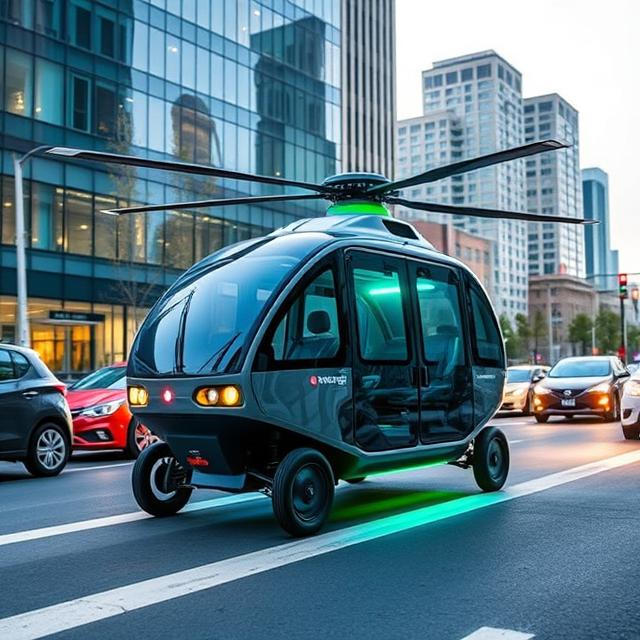How Tech Is Being Used to Improve Urban Mobility: The Role of Urban Air Mobility Vehicles and Leading Companies in the Industry

Urban populations are growing at a fast pace across the globe, contributing to congestion, pollution, and inefficiencies in transportation systems. Cities are, therefore, looking for new solutions, and urban air mobility vehicles (UAMVs) turn out to be an emerging transformative technology for improving urban mobility. These aerial transport systems not only improve the speed but also increase the sustainability and efficiency of transport as compared to conventional ground transport systems. Several urban air mobility companies are promoting innovation in the space in developing cutting-edge technologies that will change the ways people and goods move in cities.
What Are Urban Air Mobility Vehicles?
Urban air mobility vehicles mean a very new sort of aerial transport meant for within-city, short-distance travel. These vehicles include electric vertical take-off and landing (eVTOL) aircraft, drones that can fly autonomously, and hybrid air-taxis. UAMVs differ from helicopters in that they mostly use electric propulsion systems that are less noisy, ecological, and economically viable.
Several advantages make urban air mobility vehicles a game-changer:
- Reduced Traffic Congestion: The use of the airspace renders such machines far less of a burden in comparison to road congestion.
- Lower Carbon Footprint: Many UAMVs are either electric or hybrid; hence they are able to cut down emissions drastically when compared to transportation that is still powered by fuel.
- Increased Efficiency: They provide speedier journeys as compared to the ground for short-to-medium distances for both passengers and freight.
Leading Urban Air Mobility Companies
Several urban air mobility companies are at the forefront of developing and deploying UAM solutions. Investments are made in research, technology, and the infrastructure necessary to make aerial transport a commercial reality.
-
Joby Aviation
Joby Aviation is a company that is seen to be the most advanced in the UAM field, with an emphasis on developing eVTOL aircraft for air taxi use. With the significantly big back-up from investors and collaborations with airlines, Joby prefers to soon establish commercial air mobility services.
-
Lilium
Lilium, a set-up in Europe, is developing a very efficient and fast eVTOL jet. Their aircraft shall be capable of traveling long distances compared to other urban air mobility solutions.
-
Archer Aviation
Archer Aviation is focused on developing eVTOL aircraft optimized for urban transportation. The company has secured strategic partnerships with some major automotive and aerospace firms to fast-track UAM adoption.
-
Volocopter
Volocopter has pioneered the design of autonomous air taxis and has successfully tested them in various countries. The intention is to seamlessly integrate them into existing public transport systems.
How Technology Is Enhancing Urban Air Mobility
Technology has an important role in sculpting urban air mobility vehicles.
-
Electric Propulsion Systems
Electric-powered UAMVs reduce dependence on fossil fuels, lower emissions, and offer quieter operations compared to traditional aircraft.
-
AI and Autonomous Navigation
AI and autonomous navigation systems allow air taxis to fly independently, securely and efficiently. The air traffic management system is also AI-enabled, which makes quick urban air travel possible.

How Tech Is Being Used to Improve Urban Mobility: The Role of Urban Air Mobility Vehicles and Leading Companies in the Industry
-
Smart Infrastructure
To support urban air mobility, cities are investing in vertiports – specialized landing and take-off hubs for UAMVs. These hubs integrate with public transportation systems for better connectivity.
-
5G and IoT Connectivity
Advanced communication technologies, namely 5G and IoT, will promote operational safety and efficiency. It relies on real-time data exchange between vehicles, control centers and infrastructure for smooth-UAM operations.
Challenges and Future Prospects
Despite the promising advancements, urban air mobility companies face several challenges:
- Regulatory Barriers: Almost every state and aviation authority is still finding ways of developing a safe deployment and use of the UAMVs.
- Public Acceptance: The air taxi is perceived as less safe and, clearly, a less-Practical mode of transport by quite a number.
- Infrastructure Development: Infrastructure, which entails venti ports and charging stations, must be built at a huge cost.
Going forward, however, we can comfortably say that the future of air mobility vehicles looks quite bright. When technology is put in place and regulations take up shape, aerial transport solutions will get applied to a wider scale in all the major cities of the world.
Technology is playing a pivotal role in transforming urban mobility, with urban air mobility vehicles offering an innovative solution to congestion and pollution. Leading urban air mobility companies like Joby Aviation, Lilium, and Volocopter are making great strides in the sector. Nevertheless, in the face of the challenges that abound, the future of UAM remains bright, ushering in a fast, clean, and efficient urban transport system.
